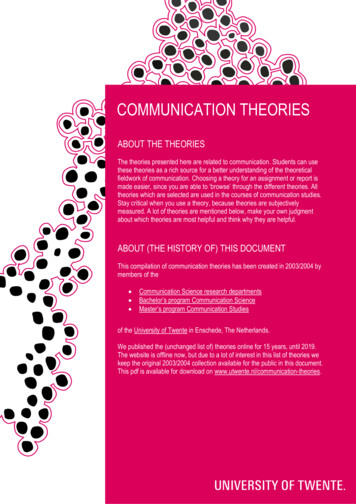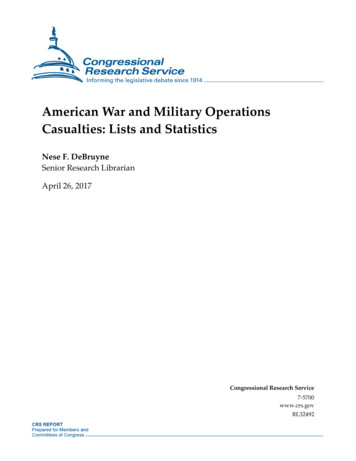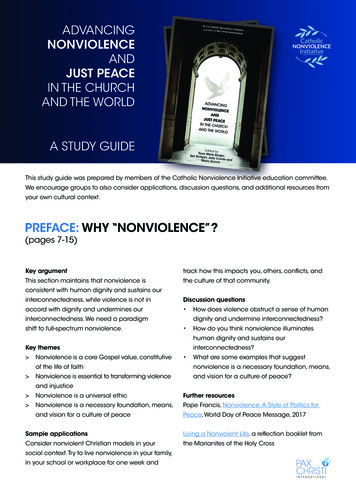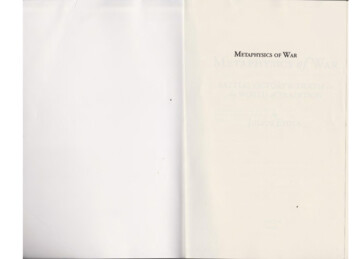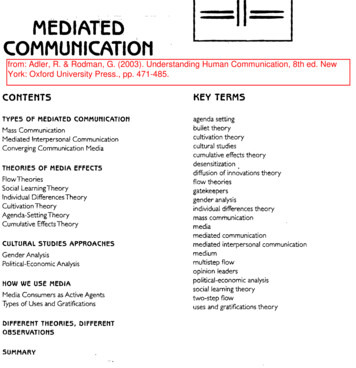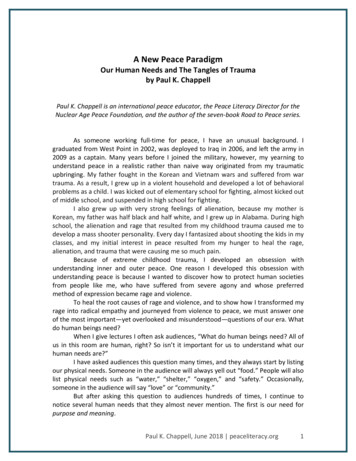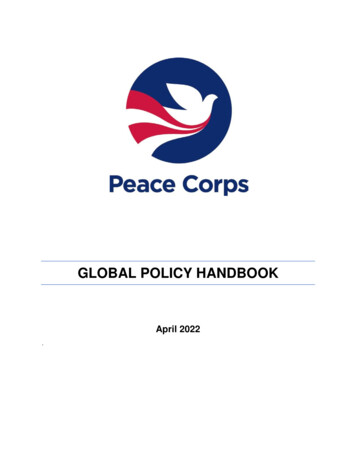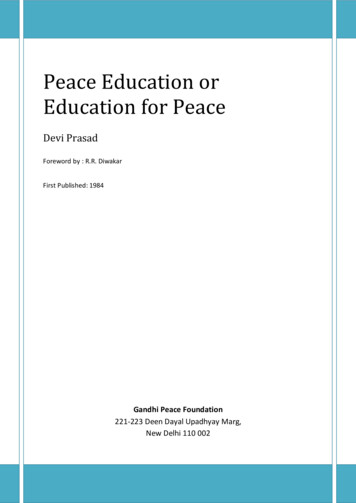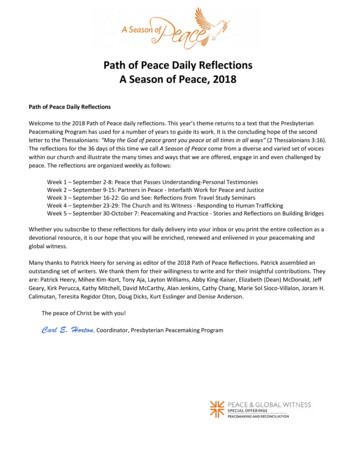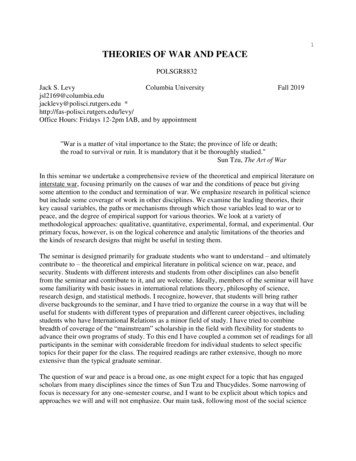
Transcription
1THEORIES OF WAR AND PEACEPOLSGR8832Jack S. LevyColumbia gers.edu *http://fas-polisci.rutgers.edu/levy/Office Hours: Fridays 12-2pm IAB, and by appointmentFall 2019"War is a matter of vital importance to the State; the province of life or death;the road to survival or ruin. It is mandatory that it be thoroughly studied."Sun Tzu, The Art of WarIn this seminar we undertake a comprehensive review of the theoretical and empirical literature oninterstate war, focusing primarily on the causes of war and the conditions of peace but givingsome attention to the conduct and termination of war. We emphasize research in political sciencebut include some coverage of work in other disciplines. We examine the leading theories, theirkey causal variables, the paths or mechanisms through which those variables lead to war or topeace, and the degree of empirical support for various theories. We look at a variety ofmethodological approaches: qualitative, quantitative, experimental, formal, and experimental. Ourprimary focus, however, is on the logical coherence and analytic limitations of the theories andthe kinds of research designs that might be useful in testing them.The seminar is designed primarily for graduate students who want to understand – and ultimatelycontribute to – the theoretical and empirical literature in political science on war, peace, andsecurity. Students with different interests and students from other disciplines can also benefitfrom the seminar and contribute to it, and are welcome. Ideally, members of the seminar will havesome familiarity with basic issues in international relations theory, philosophy of science,research design, and statistical methods. I recognize, however, that students will bring ratherdiverse backgrounds to the seminar, and I have tried to organize the course in a way that will beuseful for students with different types of preparation and different career objectives, includingstudents who have International Relations as a minor field of study. I have tried to combinebreadth of coverage of the “mainstream” scholarship in the field with flexibility for students toadvance their own programs of study. To this end I have coupled a common set of readings for allparticipants in the seminar with considerable freedom for individual students to select specifictopics for their paper for the class. The required readings are rather extensive, though no moreextensive than the typical graduate seminar.The question of war and peace is a broad one, as one might expect for a topic that has engagedscholars from many disciplines since the times of Sun Tzu and Thucydides. Some narrowing offocus is necessary for any one-semester course, and I want to be explicit about which topics andapproaches we will and will not emphasize. Our main task, following most of the social science
2literature on war and peace, is to explain variations in war and peace over time and space. Arewars more likely to occur under some conditions than other conditions, at some times rather thanother times, between some states rather than other states, under the direction of some types ofleaders rather than other types of leaders? Under what conditions are wars likely to escalate orexpand, and when are they likely to end? As the late Stuart Bremer asked, “Who Fights Whom,Where, When, and Why?”We will focus primarily on interstate war, for many reasons. Although the most common forms ofwar in the international system have shifted in recent decades away from interstate war andtowards civil war, insurgency, counterinsurgency, terrorism, hybrid war, and various forms ofcommunal violence, there is little reason to believe that the era of interstate war has ended. Thereare enough “hot spots” in the world today to create a non-trivial risk of interstate war, and U.Spolitical leaders have recently emphasized a return to an era of great power competition. Thepotential consequences of some of these wars – for human security, for the economy, and for theevolution of the international system – alone make them worthy of study. In addition, manyimportant theoretical debates in the IR field are closely linked the origins and escalation ofinterstate war, so that a familiarity with this literature is quite valuable for those wishing toengage the IR field as a whole. Finally, there is a practical consideration: the Department atColumbia has several scholars who have considerable expertise in terrorism, civil war, and otherforms of intrastate conflict, so a division of labor based on comparative advantage is beneficial.Similarly, the Columbia faculty’s expertise on nuclear weapons and strategy lead me to minimizecoverage of that important area.In our treatment of interstate war, we will not give much attention to the strategy or conduct ofwar, except to the extent that these considerations influence the outbreak, escalation, ortermination of war. Following most of the mainstream literature, we also focus more on thecauses of war than on the termination or consequences of war, though in recent years scholarshave devoted more attention to war termination and to the impact of war on the political,economic, and social structures of state and society. Finally, we spend relatively little time on thenormative and policy implications of our theories. This is not to say that these other subjects areany less important than those covered in this seminar. In a one-semester course, however, it isnecessary to make some choices for the sake of coherence. Plus, the prevailing norms of theInternational Relations field (and hence incentives for Ph.D. students planning to go on the U.S.academic job market) give priority to the construction and testing of theoretical propositions overpolicy prescription and analysis. I understand, of course, that some students may have differentcareer objectives.This syllabus includes a far more extensive list of topics and sources than we will actually coverin the class. It serves as an analytically-organized bibliography of the field, though admittedly anincomplete and perhaps somewhat idiosyncratic one. It has evolved over many years, and I spenda lot of time updating and revising it for each new course. I hope it is useful. If you find any typosor duplications, or have suggestions for additions or deletions or shifting particular works fromone category to another, I would be happy to hear from you.
3READING:The required reading for the class includes one book and a substantial number of articles andchapters. The book,Jack S. Levy and William R. Thompson, Causes of War (Wiley-Blackwell, 2010),is available for purchase at Book Culture (536 W. 112 St; 212/865-1588) and also on the internet,probably at better prices. I have asked Columbia Library to place the required book on reserve.I will put pdf’s of all required article–length pieces (but not the Levy-Thompson book, except forchapter 1 for our first day) on the Courseworks website for the class(https://courseworks.columbia.edu/ ), organized by week. In case any new student is unfamiliarwith Courseworks, I will email you pdf’s of the readings for the first week of class.COURSE REQUIREMENTS:We will organize our weekly meetings as follows. I will usually begin with my own introductorycomments on a particular body of literature, with the aim of putting the current literature in thecontext of earlier work and other bodies of literature. We will then move to an open discussion ofthe material. Most weeks we will cover several distinct topics. We will focus primarily in thelogical coherence of the theoretical argument, the appropriateness of the research designs andparticular methods for testing the theoretical argument, and implications for other conflicttheories. We will identify the strengths as well as the weaknesses of a research program or of aparticular article, and to identify useful directions for future research. We want to ask not onlywhat is wrong with particular theories and efforts to test them, but also what is good about themand what we can do better. We can discuss historical examples bearing on various theories, butour aim is to use these examples as vehicles for illustrating theories and their limitations, not toengage in extensive debate the best explanations of particular historical events.Our class discussions will be most useful, collectively and individually, if each student completesall of the required reading prior to each class meeting, comes to class prepared to discuss thereading, and actively participates in the discussion. I will try to make a few comments at the endof each class about things to think about in the reading for the following week, and which topicsor readings to prioritize for discussion. In addition, I will ask each student to select, from a listprovided below, three topics to which they will give special attention and come to classparticularly well-prepared to discuss. This may involve reading one or two articles beyond therequired reading on that topic.The above-mentioned requirement is somewhat informal but important. The more formalrequirement is to write a paper on a subject of your choice relating to war. I understand that manyof you plan to focus your graduate work on topics relating to civil war, counterinsurgency,terrorism, and other aspects of intrastate war, and for that reason I have no objection to papers onthose topics as long as they related to war and peace broadly defined. Those papers should be
4informed by our readings for the class where they are relevant. I now turn to each of theserequirements in more detail.Requirement #1: Topics for Special AttentionEach student will select three of the following topics, read the two or (usually) three articles listedfor each, and come to class especially well prepared to discuss these topics. Students will not givea formal presentation on their topic nor submit anything in writing, but I will expect you to beparticularly active and well-informed in class discussion that day. If you topic comes up indirectlyduring a different week, I encourage you to speake out. We can have up to two students on aparticular topic, so please inform me of your preferred topic as soon as possible. My Rutgersemail is the best way to contact me.Many of these readings are required for the entire class, but for several topics I include one orsometimes two additional items. I have posted pdf’s of all readings not required of the entire classin the “Readings - special topics” folder on Courseworks, organized by week within the folder.Note that you do not have to read all of the items listed for a particular week in the “specialtopics” folder, only those listed with your topic in the following list. Let me know immediately ifyour readings are missing from Courseworks.The list below includes the week of the term and topic number in the syllabus. I identify thereadings by the author’s name and date of publication. If a reading comes from a different topic, Iwill list the topic number. In some cases I give you a choice of readings. Let me know if anythingis unclear.Evolutionary approaches (2a)Wrangham (2006)Mead (1968)Gat (2009) or Thayer (2000)Security dilemma and the spiral model (3b)Jervis (1976)Jervis (1978, 3c)Glaser (1997)Offensive/defensive balance (3e)Jervis (1978)Levy (1984)Glaser & Kaufman (1998) OR Biddle (2001)Offensive realism (3g)Mearsheimer (2001, required reading for 3g)Mearsheimer (2001, chap. 5)Walt (2002, from 3a)
5Defensive realism (3h)Walt (1985)Kydd (1997)Betts (1999)Balance of power theory (4b)Gulick (1955)Levy and Thompson (2010, from 4f)Levy and Thompson (2005, from 4f)Alliances and war (4e)Crawford (2011)Morrow (2000)Johnson & Leeds (2011)Territory and the Steps-to-War Model (4o)Sensee & Vasquez (2008), chap. 1 & 2Toft (2014, from 4n)Power transition theory (5a)Tammen (2000)DiCicco and Levy (1999)Gilpin (1988, 5b)Preventive war (5d)Levy (2008)Vasquez (2014: “Was the First World War a preventive War?” (focus on criteria, not WW1)Schroeder (2011)Strategic rivalry (5k)Thompson (2001)Goertz and Diehl (in Midlarsky, 2000)Bargaining model of war (6b-e) [requires some familiarity with game theory]Fearon (1995)Powell (2006, 6c)Streich and Levy (2016, 6i)Democratic peace: Schultz Signaling Model (7e)Schultz (2001), chap. 1-3Levy and Mabe (2004, from 9f)
6Democratic peace: Selectorate Model (7f)Russett and Starr (2000, 7b)Owen (1994, 7b)Bueno de Mesquita et al (1999, 7f)Economic Interdependence and the Capitalist Peace (8c,d,h)Mansfield and Pollins (2001, 8c)Copeland (2015)Mousseau (2009) OR Gartzke and Westerwinter (2016)Financing War (8h)Schultz & Weingast (2003)McDonald (2007) OR Flores-Macías & KrepsSectoral Interests and Coalitional Politics (8i)Lobell (2004)Snyder (1991)Diversionary theory of war (9a)Levy (1989)Haynes (2017)Chiozza & Goemans (2011, from 9b)Norms and War (9l)Zacher (2001)Tannenwald (2005)Fazal (2012)Do Leaders Matter? (10b)Jervis (2013)Levy (2015)Psychology of threat perception/misperception and war (10e,f)Jervis (1988)Levy (1983)Yarhi-Milo (2013)Stein (2013, 10g)Analogical Reasoning and Learning from History (10g)Jervis (1976)Levy (1994)Khong (1992, chap.2)
7Prospect theory and war (11a)Kahneman and Tversky (1979)Levy (1997)Taliaferro (in Political Psychology 2004)Strategic Culture (11h)Johnston (1995)Choose two: Kier (1995) OR Legro (1994), OR Rhodes (1996)Intelligence failure (11j)Bar-Joseph & Levy (2009)Choose two: Betts (2007-08) OR Jervis (2006) OR Jervis (2010, chap. 3, no pdf provided)Audience costs (12c)Fearon (1994)Snyder and Borghard (2011)Kertzer and Brutger (2016) OR Levy et al (2015)Status and War (12f)Dafoe et al (2014)Renshon (2016)Jervis AND Betts in 2012 SS Symposium, OR Wolf (2014)The Expansion (Spread) of War and the Case of the First World War (13d, e)Vasquez (2018)Levy (1990-91)Requirement #2: paperGiven that students in the class will have different backgrounds and goals and may be at differentstages in the graduate program, the paper requirement is somewhat flexible. I recognize that someof you may be primarily interested in forms of conflict other than interstate war, and consequentlyI will allow papers on any topic relating to international conflict broadly defined (civil war,insurgency, terrorism, etc.), not just interstate war. Note, however, that if some of the materialcovered in class relates to parts of your paper on intrastate conflict, you should include it. In termsof the type of paper, it can be a literature review, research design, or research paper. If you are afirst year student, or perhaps someone outside of the IR field, a literature review paper might beappropriate. If you are further along and have an idea for a research paper but are just gettingstarted on it, maybe a research design would be best. If you are a more advanced student and havestarted to do research on a particular topic, then a research paper makes more sense. The type ofpaper is up to you, but whatever you do must go significantly beyond what you have done beforeon a similar paper in other classes.You should inform me, verbally or by email, of the topic you wish to pursue. I will probably askfor a longer written statement of your question and how you plan to go about analyzing it. For
8literature reviews, this might involve a preliminary outline and provisional bibliography at somepoint. For research papers, this might involve a 3-5 page research design. Basically, I will ask fora few intermediate products along the way to your final paper, to make sure we are on the samepage and to provide hopefully feedback along the way.Style: All papers should be single space with a space between paragraphs, with footnotes ratherthan endnotes, and submitted to me by email attachment. Any citation style is acceptable, as longas you are consistent. However, even if you use a traditional footnote style – as detailed inChicago Manual of Style and adopted by International Security, Security Studies, and some otherjournals) – please include a separate bibliography at the end of the paper (even though that styledoes not formally require a cumulative bibliography. The due date is Friday, December 13, aweek after our last class.Literature reviews should be 11-15 pages. This should be a critical review of the literature on awell-defined theoretical question or set of interrelated questions relating to war, peace, andsecurity. It can overlap with one or your three topics for requirement #1. Good paper topics oftencoincides with a section or subsection of the course, but sometimes span several topics. Forexample, a broader topic might be balance of power theory or power transition theory, whilenarrower topics might be alliances and war, preventive war, or territory and war. In order toavoid misunderstandings, please secure my approval for your paper topic in advance.I have included extensive bibliographies in the hope that they serve as useful guides, or at leastpoints of departure, for many possible paper topics. I encourage you to utilize additional sources.This will be absolutely necessary on topics where my lists of sources is rather limited. Please donot assume that by reading all of the items in a particular section of the syllabus you haveadequately covered a particular topic for your review. On topics where the list of sources is muchlonger, you may need to narrow the list considerably, while hopefully adding a few additionalsources. In either case, please consult me for suggestions as to possible additions to the list and/orpriorities among them (if the number of items is quite large). The order of items on the syllabus israrely an indicator of their relative importance.In your literature review you should summarize the literature on your topic and at the same timeorganize it in some coherent way – preferably around a useful typology or theoretical theme, notaround a succession of books and articles. You should note the theoretical questions that thisliterature attempts to answer, identify the key concepts and causal arguments, note some of theempirical research that bears on these theoretical propositions, and relate it to the broaderliterature on war and peace. You should identify the logical inconsistencies, broader analyticallimitations, and unanswered questions of the leading scholarship in this area. You should alsosuggest fruitful areas for subsequent research. If you have any thoughts on how particularhypotheses could be tested, please elaborate on that.Early in the term I will post copies of a few sample literature reviews from previous courses, togive you a few models of what good papers look like. Those papers will also give you a sense of
9many sources are appropriate, though that will vary by topic. How you organize your review andwhat you say about the sources is more important than the length of your bibliography.Research designs should identify the question you are trying to answer, ground it in thetheoretical literature, specify your key hypotheses, offer a theoretical explanation for thosehypotheses, and provide a detailed statement as to how you would carry out the research. Thisincludes the specification of the dependent and independent variables and the form of therelationship between them, the operationalization of the variables, the identification (andtheoretical justification) of the empirical domain of the study (i.e., case selection), theidentification of alternative explanations for the phenomenon in question, and anacknowledgment of what kinds of evidence would confirm your hypotheses and what kinds ofevidence would disconfirm or falsify your hypotheses. Try to do this in 12-15 pages (singlespace). Please consult with me along the way, starting with a one page statement early in therterm. I am hoping for research designs that are roughly equivalent to rough drafts of dissertationproposals or grant proposals (which, admittedly, vary in length).Research papers include research designs and basically implement them. For the purposes of thisclass, the research need not necessarily be complete. For example, if your design calls for fourcomparative case studies, and you complete only one or two for this class, that is fine. There is noset length for the paper. However, if you are aiming at an article-length paper that will ultimatelybe submitted to a journal, note that most journals have word limits ranging from 12-15,000 words,including footnotes and references but not including any technical appendices. (I think that worksout to 23-27 pages, single space, though journals always require double space.) The paper for thisclass need not be that long.GradingGrades for the course will be based on the following weighting:Contributions to class discussion,20%including on your three topics for special attentionPaper80%Academic IntegrityThe intellectual venture in which we are all engaged requires of faculty and students alike thehighest level of personal and academic integrity. As members of an academic community, eachone of us bears the responsibility to participate in scholarly discourse and research in a mannercharacterized by intellectual honesty and scholarly integrity.Scholarship, by its very nature, is an iterative process, with ideas and insights building one uponthe other. Collaborative scholarship requires the study of other scholars' work, the free discussionof such work, and the explicit acknowledgement of those ideas in any work that inform our own.
10This exchange of ideas relies upon a mutual trust that sources, opinions, facts, and insights will beproperly noted and carefully credited.In practical terms, this means that, as students, you must be responsible for the full citations ofothers' ideas in all of your research papers and projects; you must be scrupulously honest whentaking your examinations; you must always submit your own work and not that of anotherstudent, scholar, or internet agent.Any breach of this intellectual responsibility is a breach of faith with the rest of our academiccommunity. It undermines our shared intellectual culture, and it cannot be tolerated. Studentsfailing to meet these responsibilities should anticipate being asked to leave Columbia.Disability AccommodationsIn order to ensure their rights to reasonable accommodations, it is the responsibility of students toreport any learning-related disabilities, to do so in a timely fashion, and to do so through theOffice of Disability Services. Students who have documented conditions and are determined byDS to need individualized services will be provided a DS-certified ‘Accommodation Letter.’ It isstudents’ responsibility to provide this letter to all their instructors and in so doing request thestated accommodations.If you are a student with a disability and have a DS-certified ‘Accommodation Letter,’ pleasecome to my office hours to confirm your accommodation needs. If you believe that you mighthave a disability that requires accommodation, you should contact Disability Services at 212-8542388 and disability@columbia.edu. For more information, please onsibilities.
11TOPICAL OUTLINE1.COURSE INTRODUCTION (Sept. 6)CONCEPTUAL ISSUES, IWhat is War?The Clausewitzian ParadigmIs Clausewitz Still Relevant?Trends in WarThe Levels-of-Analysis Framework2.CONCEPTUAL ISSUES, II (Sept. 13)Evolutionary Approaches: What Do They Explain?Typologies of WarThe Concept of Total WarThe Use of Force: Contemporary ClausewitziansConcepts of Causation3.REALIST THEORIES OF WAR, I (Sept. 20)Varieties of Realist TheoriesThe Security Dilemma and the Spiral ModelThe Prisoner’s Dilemma Model, I – single-playThe Prisoner’s Dilemma Model, II – repeated-playThe Offensive/Defensive BalanceNeorealist Theories of WarOffensive RealismDefensive RealismDefinition and Measurement of Military PowerMilitary Effectiveness4.REALIST THEORIES OF WAR, II (Sept. 27)Neoclassical RealismClassical Balance of Power TheoriesConceptual AmbiguitiesHistorians’ PerspectivesDebates about Bipolarity, Mulitpolarity, and WarQuantitative Studies of Polarity and of Systemic Capability ConcentrationThe Dyadic Power Parity HypothesisAlliances and WarDebates over Balancing vs. BandwagoningDo Alliances Deter Provoke War? Quantitative StudiesFormal Models of AlliancesAlliance DataAlliance Cohesion in WartimeDomestic Sources of Alliances
12Whom Do States Balance Against? Land Powers and Sea PowersWhat Do States Balance Against? Disaggregating PowerBalancing (or not) in Non-Western Systems“Soft Balancing”Lateral Pressure TheoryAsymmetric ConflictsISSUES, TERRITORY, AND THE STEPS TO WAR MODELIssues: What Do States Fight About?Issues Correlates of War Project (ICOW)Territory and WarBorders and WallsThe Steps-to-War Model5.HEGEMONIC THEORIES (Oct. 4)Power Transition Theory – The Organski et al Research ProgramGilpin's Hegemonic Transition TheoryHistorical PerspectivesPower Transition Theory and the Rise of ChinaPreventive WarHistorical ApplicationsPreventive Logic in the Nuclear AgeRising and Declining PowersLong Cycle Theory (Thompson, Rasler, Modelski)Hegemonic WarOther Theories of Hierarchy, Transition and WarTheories of Unipolar PoliticsDavid Kang’s Research Program on Hierarchy in AsiaRIVALRIES AND ARMS RACESInternational RivalriesOverviewThe Diehl & Goertz Research ProgramThe Thompson/Rasler/Colaresi Research ProgramRivalry TerminationOther Approaches to RivalryArms Races and WarHistorical StudiesQuantitative and Formal Approaches
136.THE BARGAINING MODEL OF WAR (Oct. 11)Rational Choice Theories: IntroductionThe Bargaining Model of WarThe Commitment ProblemInformational ProblemsIssue IndivisibilityComplications of Multilateral BargainingOther Formal Models of BargainingSpatial ModelsThe Non-Formal Literature on Misperceptions and their ConsequencesBehavioral Perspectives on the Bargaining Model of War7.THE DEMOCRATIC PEACE (October 18)Societal-Level Theories of War: OverviewsThe Democratic PeaceQuantitative Empirical StudiesMonadic LevelSystem levelCritiquesDomestic Oppositions and Signaling (Schultz)Alternative Models of Political Oppositions and SignalingSelectorate Theory (Burno de Mesquita et al)War and the Survival of Political Leaders: Empirical StudiesThe Territorial PeaceWhy Do Democracies Win Wars?Other Implications of the Democratic PeaceCovert ActionA Democratic Civil Peace?More on Democratic AccountabilityDemocratization and WarPresidential and Parliamentary DemocraciesAutocracies, War, and Peace8.ECONOMIC THEORIES OF WAR AND PEACE (Oct. 25)General TreatmentsMarxist-Leninist TheoriesAlternative Theories of ImperialismResources and WarDoes Trade Promote Peace?Quantitative-Empirical StudiesThe Globalization of ProductionThe Capitalist PeaceThe Contractual PeaceThe Impact of War on TradeThe Militarization of Commercial Rivalries
14World War I and Economic LiberalismFinancing WarHistorical PerspectivesThe First World WarSectoral Interests and Coalitional PoliticsThe Costs of Conflict9.SOCIETAL-LEVEL THEORIES (continued) (Nov. 1)The Diversionary Theory of WarSocial Identity TheoryDebates over MechanismsQuantitative-Empirical StudiesFormal Theoretical ApproachesCase StudiesLeaders, Institutions, Political Survival, and WarDiversionary Theory, Political Oppositions, and Signaling (back to Schultz)Public Opinion and WarOther Domestic Frameworks and StudiesRevolution and WarIDEATIONAL AND CULTURAL APPROACHESIdeas, Ideology, and WarCulture and WarRace and WarReligion and WarA Data SetHistorical PerspectivesThe “Clash of Civilizations” (Huntington)Attitudes toward WarNorms and WarExperimental StudiesThe Law of War and Its ImpactPaul W. Schroeder’s Research Program on Ideas and Norms10.DECISION-MAKING: THE INDIVIDUAL LEVEL, I (Nov. 8)OverviewsDo Leaders Matter?Backgrounds and Characteristics of LeadersBeliefs and ImagesImages of the EnemyMsperception and the Causes of WarPsychology of Threat PerceptionEmotions, Political Interests, Motivated Reasoning, and WarNeurobiological ApproachesAnalogical Reasoning and Learning from History
1511.DECISION-MAKING – THE INDIVIDUAL LEVEL, II (Nov. 15)Prospect Theory Goes to WarTime HorizonsOther Psychological Models of ConflictPsychoanalytic ApproachesDECISION-MAKING – THE ORGANIZATIONAL LEVELDecision-Making in GroupsBureaucratic Politics and Organizational ProcessesApplications to the Causes of WarCrisis Decision-making: The Impact of StressDefinitions of CrisisStrategic CultureCivil-Military RelationsMilitarismDecision-Making in Advisory Systems and Small GroupsIntelligence FailureHistorical CasesMilitary Doctrine and Military InnovationCommand and ControlTHE PRESIDENT, CONGRESS, AND WAR12.SIGNALING, REPUTATION, RESOLVE, AND STATUS (Nov. 22)SignalingReputation and Signaling: Formal ModelsReputation: Empirical and Experimental StudiesReputation and ResolveAudience CostsStatus and War13.THE ESCALATION AND EXPANSION OF CRISES AND WAR (Dec. 6)General Studies of Crisis EscalationModels of EntrapmentLoss of Control and Inadvertent WarCrisis (Mis)managementThe Expansion (Spread) of WarThe Case if the First World WarDuration of WarImplications of the Bargaining ModelPsychological Perspectives and DebatesSOME ANALYTIC ISSUESMethodological Issues: QuantitativeMethodological Issues: QualitativeFuture Directions in the Study of Interstate War
16APPENDICIESA-1DATA SETS ON INTERSTATE WARSince 1815Since 1945Since 1500 or BeforeA-2IS WAR DECLINING?A-3THE EVOLUTION OF WARBiological, Primatological, and Evolutionary PerspectivesAnthropological studies of the origins of warArchaeological PerspectivesHistorians’ TreatmentsThe “Military Revolution” and the Rise of the StateA-4THE NUCLEAR ERATheoretical Foundations of Strategic TheoryNuclear Weapons and the Long PeaceEmpirical Studies of the Impact of Nuclear Weapons, I: QualitativeEmpirical Studies of the Impact of Nuclear Weapons, II: QuantitativeNuclear Weapons and Crisis BargainingNuclear ProliferationA-5THE CHANGING NATURE
Sun Tzu, The Art of War In this seminar we undertake a comprehensive review of the theoretical and empirical literature on interstate war, focusing primarily on the causes of war and the conditions of peace but giving some attention to the conduct and termination of war. We emphasize research in political science
